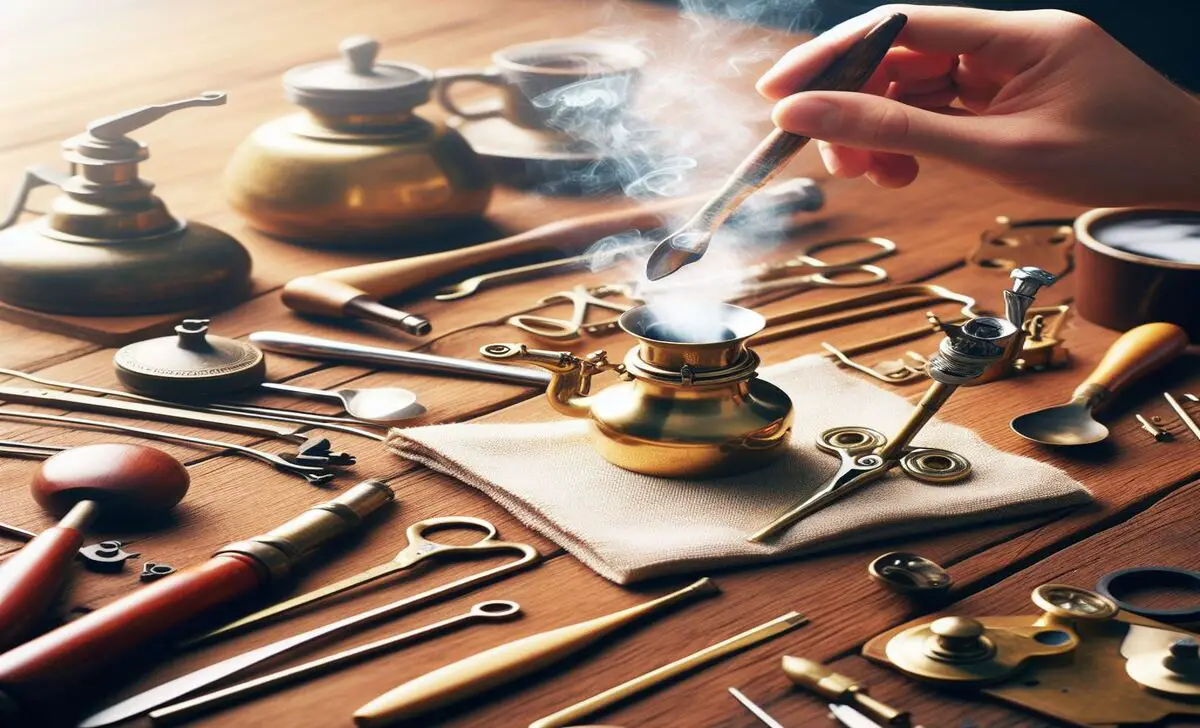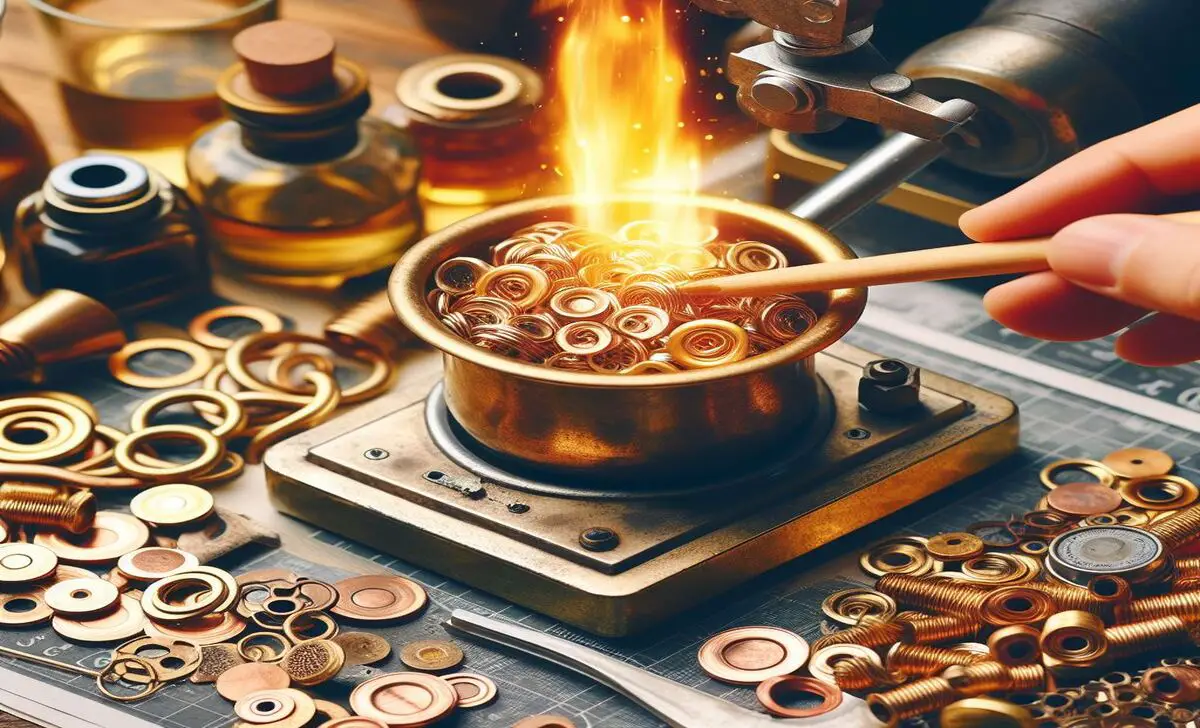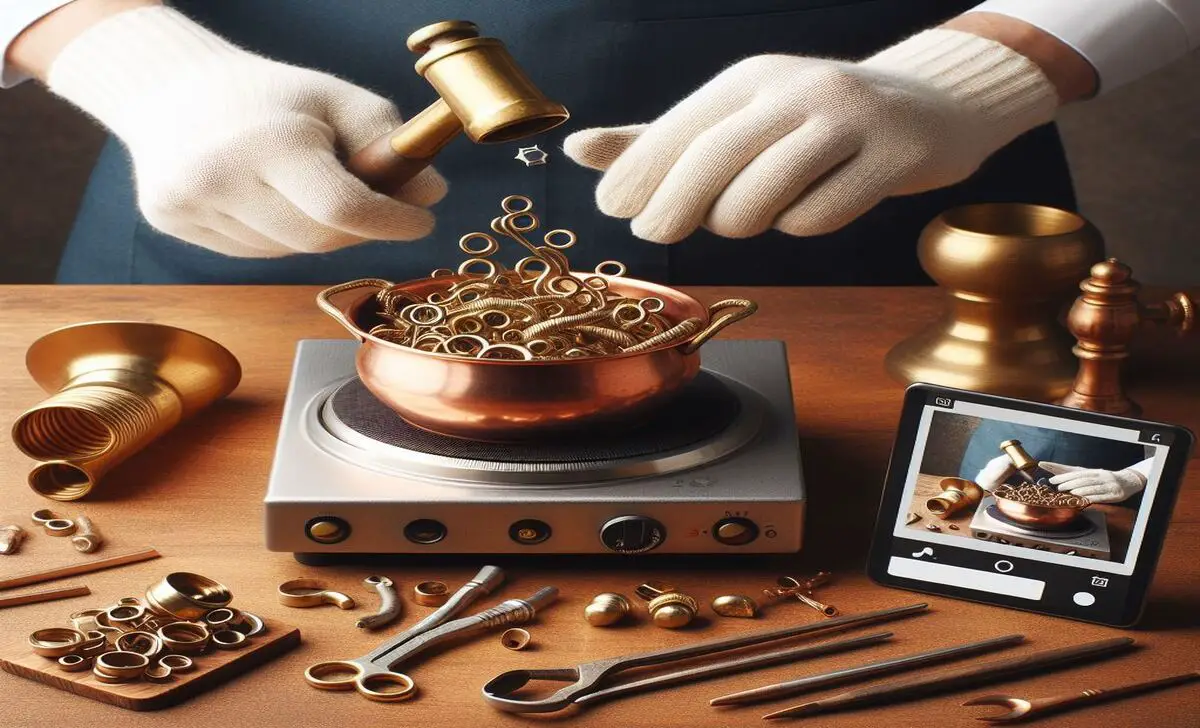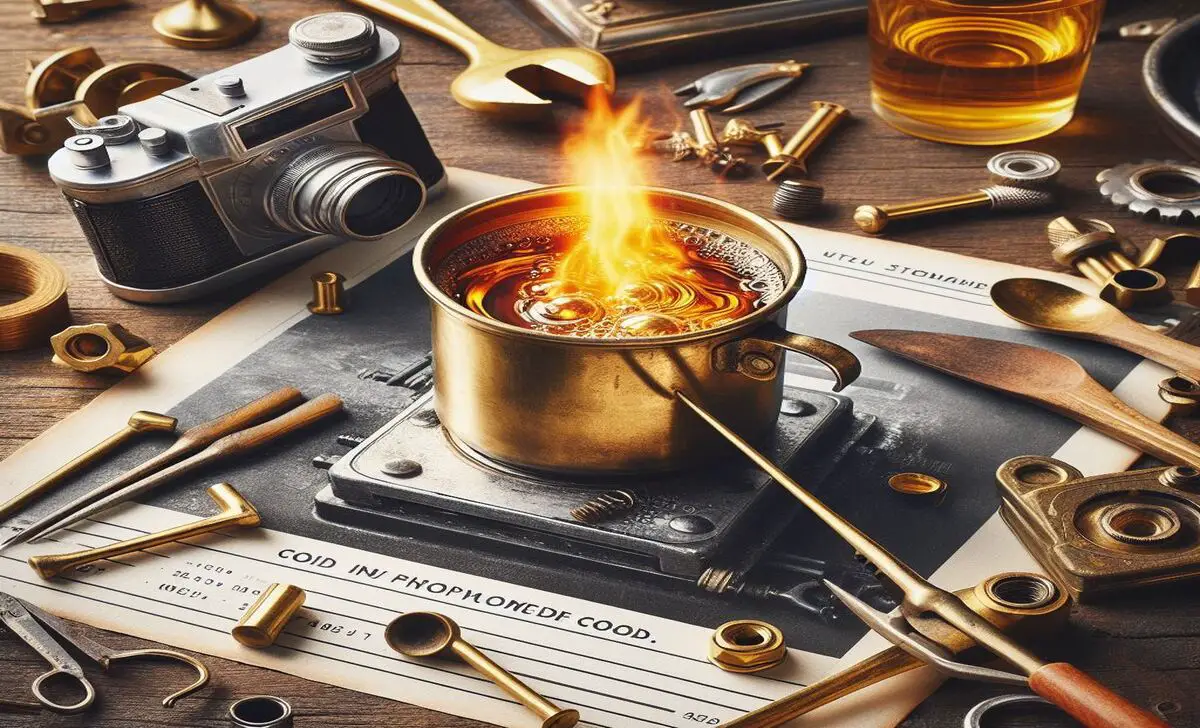Brass is a versatile and widely used metal in various industries, from plumbing and electrical to decorative and artistic applications.
Its malleability and durability make it a popular choice for many purposes, but its hardness can pose a challenge when bending it into specific shapes.
Traditional methods of softening brass, such as heating it to high temperatures or using chemical solutions, can be time-consuming, hazardous, and require specialized equipment. However, there is a simpler and safer way to soften brass for bending, using readily available materials that are easy to work with.
Here, we will discuss soften brass for bending in the simplest way, suitable for professionals and DIY enthusiasts. With this technique, you can achieve the desired flexibility in your brass pieces without compromising their strength and quality.

What Is Brass?

“Brass” is a metallic alloy made primarily of copper and zinc. It’s valued for its durability, malleability, and attractive gold-like appearance. Brass has been handy for various purposes throughout history, including in art, architecture, musical instruments, and everyday objects. Here are some key properties and uses of brass:
| Property/Use | Description |
|---|---|
| Composition | It mainly comprises copper (between 55% to 95%) and zinc (between 5% to 45%) with small amounts of other metals such as lead, tin, or aluminium. |
| Color | Typically, it has a gold-like appearance, though it can range from reddish to yellow depending on the ratio of copper to zinc. |
| Strength | Brass is known for its strength and durability, making it suitable for various structural applications. |
| Malleability | It can be easily shaped and formed into intricate designs, making it popular in decorative and artistic applications. |
| Corrosion Resistance | Brass has good corrosion resistance, particularly in marine environments, making it suitable for moisture-resistant fittings and fixtures. |
| Electrical Conductivity | Brass is a relatively good conductor of electricity, making it useful in electrical components and connectors. |
| Thermal Conductivity | It also has good thermal conductivity, making it suitable for heat exchangers and radiator cores. |
| Applications | Musical instruments (e.g., trumpets, saxophones), plumbing fittings, decorative items, hardware, ammunition casings, valves, and electrical components. |
Need To Soften Brass Before Bending

Brass is a hard and brittle metal, making it difficult to bend without cracking or breaking. Softening brass before bending is important because it makes the material more malleable and easier to shape without causing damage.
This process involves heating the brass tubes to a specific temperature and then cooling them slowly, which helps to relieve internal stresses and improve their flexibility. Softening the brass makes it more pliable and less likely to experience fractures or deformations during the bending process.
Tools You Need
Brass, a versatile alloy of copper and zinc, is widely handy in various industries for its durability, corrosion resistance, and aesthetic appeal. One crucial aspect of working with brass is understanding the importance of softening the material.
Here are the tools you need:
- Gas torch.
- Any metal vice to hold the brass.
- Water to cool the metal.
How To Soften Brass For Bending In Simplest Way

Brass, a versatile and handy alloy, is renowned for its durability, corrosion resistance, and attractive golden hue. However, over time, brass can lose its lustre and develop a dull appearance due to the oxidation process. To soften brass for bending most simply, you can follow these steps:
- Start by cleaning the brass with a mild detergent or brass cleaner to remove dirt or grime.
- Rinse the brass thoroughly with cold water and dry it completely.
- Place the brass in a heat-resistant container, such as a stainless steel pot or a ceramic bowl.
- Fill the container with enough water to submerge the brass fully.
- Add a small amount of dish soap or ammonia to the water. This will help to speed up the softening process.
- Place the container on a stove or heat source and gradually heat treatments the water. It is important to heat the brass slowly to avoid warping or damage.
- Once the water reaches a temperature of around 600 to 700 degrees Fahrenheit (315 to 370 degrees Celsius), the brass will start to soften.
- Use a pair of heat-resistant gloves or tongs to carefully remove the brass from the water.
- Immediately shape or bend the softened brass into the desired form using pliers or a bending tool.
- Allow the brass to cool down naturally and harden in the new shape.
It is important to note that this method is suitable for small brass pieces or thin sheets. If you are working with larger or thicker brass pieces, it is recommended to seek professional assistance or use specialized equipment for softening and bending. Here some are alternative tricks below:
1.Using Heat To Soften Brass

Using heat can soften brass. When heated to a specific temperature, brass undergoes a process called annealing, which helps improve its flexibility and makes it easier to work with. To soften brass, it is typically heated to around 500-600°C (932-1112°F) for a specific period and then allowed to cool slowly.
This process relieves internal stresses and allows the metal to become more malleable. However, it’s important to note that overheating brass can lead to its degradation, so it’s crucial to follow proper annealing techniques and temperature guidelines.
2.Using Chemicals To Soften Brass

One common approach involves using a mild acid solution, such as vinegar or lemon juice, to remove the tarnish and grime accumulated on the surface gently. Chemists can use chemicals in a process called annealing to soften brass. Annealing is the heating and cooling of metal to alter its properties, such as making it softer and more malleable. Here are some important points to consider when using chemicals to soften brass:
- Safety Precautions: Always wear appropriate protective gear when working with chemicals, including gloves and goggles. Ensure proper ventilation in your workspace to avoid inhaling fumes.
- Chemical Options: Various chemical solutions are available for brass softening, such as ammonium chloride (sal ammoniac) or sodium hydroxide (caustic soda). These chemicals help remove the zinc from the brass, making it softer.
- Cleaning The Brass: It is crucial to thoroughly clean the brass before applying the chemical solution. Remove any dirt, grease, or oxidation from the surface using a brass cleaner or a mixture of vinegar and salt.
- Applying Chemical Solution: Prepare a chosen chemical solution according to the manufacturer’s instructions. Immerse the brass item in the solution and heat it gradually using a propane torch or a furnace. Maintain a consistent temperature within the recommended range for brass annealing.
- Cooling Process: After heating, allow the brass to cool down slowly. This can be achieved by turning off the heat source and letting the brass cool naturally in the air, using a controlled cooling method like burying it in sand or using a heat-resistant container filled with vermiculite.
3.Using Mechanical Methods To Soften Brass

Softening brass is a process that involves removing the tarnish and restoring its malleability. Using mechanical methods to soften brass involves a process called annealing. Annealing is a heat treatment technique that helps to reduce the hardness of brass and makes it easier to work with.
Here are the steps involved in using mechanical methods to soften brass:
- Clean The Brass: Start by cleaning the brass thoroughly to remove any dirt, grease, or corrosion. You can do this using a brass cleaner or a mixture of vinegar and salt.
- Heat The Brass: Once the brass is clean, heat it using a torch or a furnace. The temperature required for annealing brass is around 600-700 degrees Celsius (1112-1292 degrees Fahrenheit).
- Monitor The Temperature: It’s important to monitor the temperature of the brass throughout the annealing process. Use a thermometer or heat-sensitive paint to ensure the brass reaches and maintains the desired temperature.
- Hold And Cool The Brass: Once the brass reaches the desired temperature, hold it for a specific period to allow the internal structure to adjust. This duration depends on the thickness and size of the brass piece.
- Cool The Brass Slowly: Slowly cool the brass to room temperature after the holding time. This can be done by turning off the heat source and allowing the brass to cool naturally or by placing it in a container filled with sand or vermiculite to slow down the cooling process.
How To Soften Brass Without A Torch For Bending

To soften brass for bending without a torch, you can utilize a method known as annealing. First, clean the brass thoroughly to remove any dirt or oils that may interfere with the process.
Then, place the brass in a heat-resistant container filled with a bed of sand or fine ash to provide even heating. Next, cover the brass completely with more sand or ash to create a protective barrier and ensure uniform heating.
Place the container in an oven preheated to around 600-700°F (315-370°C) and let the brass heat gradually for several hours. Once heated, carefully remove the container from the oven and let it cool naturally to room temperature.
This slow cooling process will help to relieve internal stresses in the brass, making it more malleable for bending. After annealing, you can safely bend the brass to your desired shape without a torch.
Safety Precautions
Brass is a versatile alloy widely used in various industries for its unique combination of strength and corrosion resistance. However, brass can lose its lustre and develop a dull appearance over time. This is where the process of softening brass comes into play. Here are some guidelines to ensure your safety:
- Wear Protective Clothing
- Work In A Well-Ventilated Area
- Use heat-resistant and non-reactive tools, such as stainless steel tongs or crucibles, to handle brass, etc.
- Handle Chemicals With Care
- Be Cautious With Heat Sources
- Dispose Of Waste Properly
Common Mistakes

Its unique properties and rich appearance make it popular in various industries and applications. However, brass can lose lustre over time and develop a dull, tarnished look.
This is where the need to soften brass arises, as it helps restore its original shine and beauty. When softening and bending brass, it is important to be aware of common mistakes that should be avoided.
Here are a few key points to keep in mind:
- Overheating: Brass can become brittle if heated too much or too long. Avoid overheating the brass during softening to prevent damage or weakened areas.
- Insufficient Annealing: Annealing is heating the brass to a specific temperature and then cooling it slowly. Insufficient annealing can result in brass that is still too hard and difficult to bend. Make sure to follow the correct annealing procedures for the specific type of brass you are working with.
- Incorrect Bending Techniques: When bending brass, using the proper tools and techniques is important to avoid introducing stress or causing cracks. Avoid sharp bends or applying excessive force, which can lead to deformation or breakage.
- Lack Of Lubrication: Brass tends to gall or seize when bent, so using an appropriate lubricant during the bending process is crucial bending process. This helps reduce friction and prevents damage to the brass surface.
- Neglecting Safety Precautions: Always wear protective gloves and eyewear when working with brass, as it can be sharp and may cause injury. Work in a well-ventilated area to avoid inhaling harmful fumes produced during heating.
Maintain The Softness Of The Brass After Bending

- Use a soft cloth to clean the brass after bending to remove dirt or debris.
- Apply a brass polish specifically designed to maintain softness.
- Gently buff the brass with a microfiber cloth to restore its lustre.
- Avoid using abrasive materials or harsh chemicals that could damage the brass.
- Store the brass item dry to prevent tarnishing and maintain its softness.
Conclusion
By following the steps on soften brass for bending in simplest way, you can easily achieve the desired level of softness in your brass and create smooth and precise bends. Taking proper precautions and using the appropriate tools and techniques is important to ensure a successful outcome.
With some practice and patience, you can master softening brass for bending and elevating your metalworking skills. Remember to always prioritize safety and precision in your projects.
So, next time you need to bend brass, remember need to anneal it for a smoother and more precise outcome. Remember these tips, and enjoy working with this versatile and malleable metal.
FAQs
1.At What Temperature Does Brass Soften?
Brass softens at temperatures around 700 to 800 degrees Fahrenheit, depending on the specific composition of the brass alloy.
2.How Do You Soften Brass For Bending By Hand?
To soften brass for bending by hand, heat it evenly with a propane torch until it reaches a dull red color, then let it cool slowly in the open air. This process helps reduce the brass’s hardness, making it easier to bend without cracking or breaking. Wear protective gear and work in a well-ventilated area using a torch.
3.How Do You Bend Metal Brass?
Metal brass can be bent by applying force to it using tools such as hammers, pliers, or a bending machine. The metal should be heated first to make it more malleable and easier to shape. Care should be taken to avoid cracking or damaging the brass during bending.
4.Does Heat Weaken Brass?
Yes, heat can weaken brass by causing it to lose strength and become more malleable, potentially leading to deformation or failure under stress. High temperatures can also cause brass to undergo stress relaxation, reducing its ability to maintain its shape and integrity.
It is important to consider the effects of heat on brass when using it in applications where temperature fluctuations or exposure to heat may occur.
5.Does Brass Soften When Heated?
Yes, brass does soften when heated. Heating brass causes it to undergo an annealing process, rearranging the metal’s internal structure, making it more malleable and easier to shape.
6.How To Make Brass Flexible For Bending
Brass can be made more flexible for bending by annealing it. This process involves heating the brass to a high temperature and then allowing it to cool slowly, which helps to reduce its hard brass and increase its malleability. Once annealed, the brass can be easily bent and shaped without breaking.
7.How To Soften Brass Without Heat For Bending
One way to soften brass without heat for bending is to use a brass softening solution or metal conditioner. These products are designed to chemically soften the brass, making it more pliable and easier to bend.
Simply apply the solution to the brass, let it sit for the recommended time, and then attempt to bend it. Follow the manufacturer’s instructions carefully to achieve the desired results.
8.How To Soften Brass Without Annealing For Bending
To soften brass without annealing it for bending, you can heat it with a torch until it reaches a cherry red color, then quench it in cold water. This process, known as “tempering,” can help make the brass more malleable for bending without affecting its overall structure like annealing would.
However, be cautious not to overheat the brass, which can lead to cracking or brittleness. Always test on a small piece first to ensure the desired softness before bending the entire piece.

I am passionate about tools and electric work. I love finding new tools and experimenting with them.


How do you heat water to 600F???